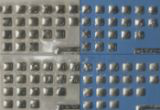
New technologies in the printed electronics industry have fostered an increased interest in low-temperature polymer thick film products. Industry expectations are demanding that low-temperature products perform at the same level as their high-temperature counterparts, including high reliability, strong adhesion, and solderability with lead-free solders.
Much of the shift to lead-free solders is due to environmental concerns and legislation that has surfaced over the past 15 years. Traditionally, it has only been possible to use leaded solders for soldering to polymer-based thick film conductors. While using lead-free solders is beneficial both to the industry and the environment, they pose challenges during processing. The high temperatures required for lead-free soldering generate a harsh environment that is too severe for polymer thick film pastes to survive.
Using New SubstratesAs the electronic industry moves towards flexible electronics, they are realizing the benefits in using substrates such as treated glass and aluminum that require a low-temperature-processing, polymer thick film. These materials not only offer a cost-effective approach to building complex, integrated circuits, they also provide a viable option to manufacturers dealing with the new demands of substrates that cannot handle temperatures higher than 500°C.
Polymer thick film materials have the versatility to be engineered depending on substrate and preferred application method such as screen printing, stencil printing, dispensing, dipping, and roll-to-roll printing. For traditional thick film materials, additive processing has always offered benefits including ease of use, simple design changes, and the ability to manufacture patterns from simple circuits to intricate designs.
The addition of polymer thick film to this category not only continues to have these listed advantages but also brings new gains such as: low temperature processing, quick-curing steps, and the ability to offer many of the same benefits as high-temperature thick film material without the need for the traditional firing step.
Despite the known advantages for polymer thick film materials, they are not as widely accepted in the industry as equivalent alternatives to their standard high-temperature thick film counterparts. This is due to two disadvantages – reliability and process-ability – prevalent in polymer thick films. Although many polymer thick films are considered to be reliable, they do not have the typical life span of a cermet (ceramic-metal) paste.
It is difficult to use lead-free solders when working with polymer materials. Frequently, the processing temperatures of the solders are greater than those of the polymers used to create the conductive pastes. This leads to the leaching of the conductive materials and the poor wetting of the solder.
To solve these problems, a new polymer thick film paste has been developed that is compatible with a variety of substrates and readily accepts lead-free solder. This easy-to-process paste features low temperature curing (150°C – 200°C); offers excellent solderability with SAC305 solder; and is RoHS- and REACH compliant. It allows conductive polymer pastes to be used in a variety of functions such as position sensors, low-temperature heater applications, and tempered-glass connection points.